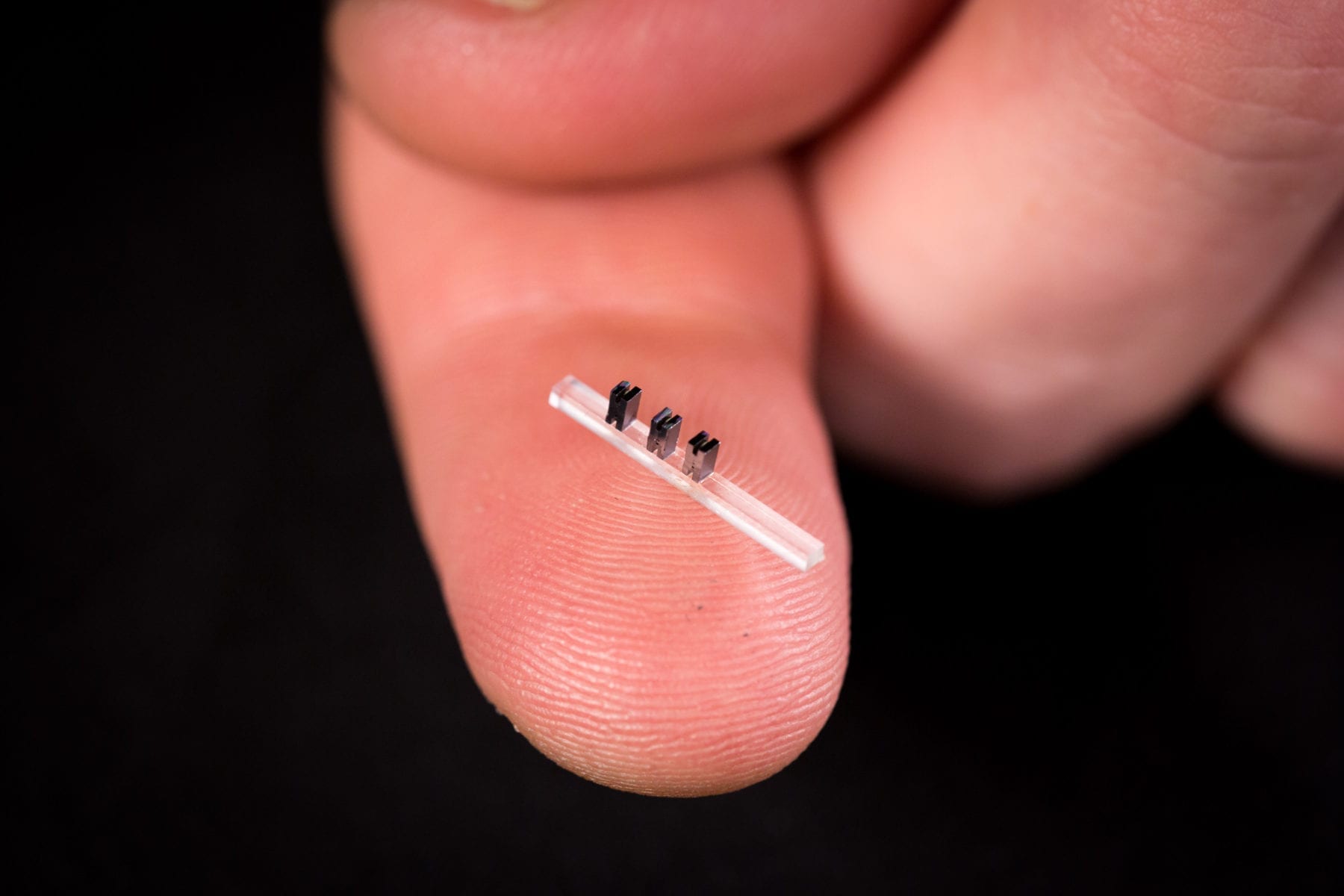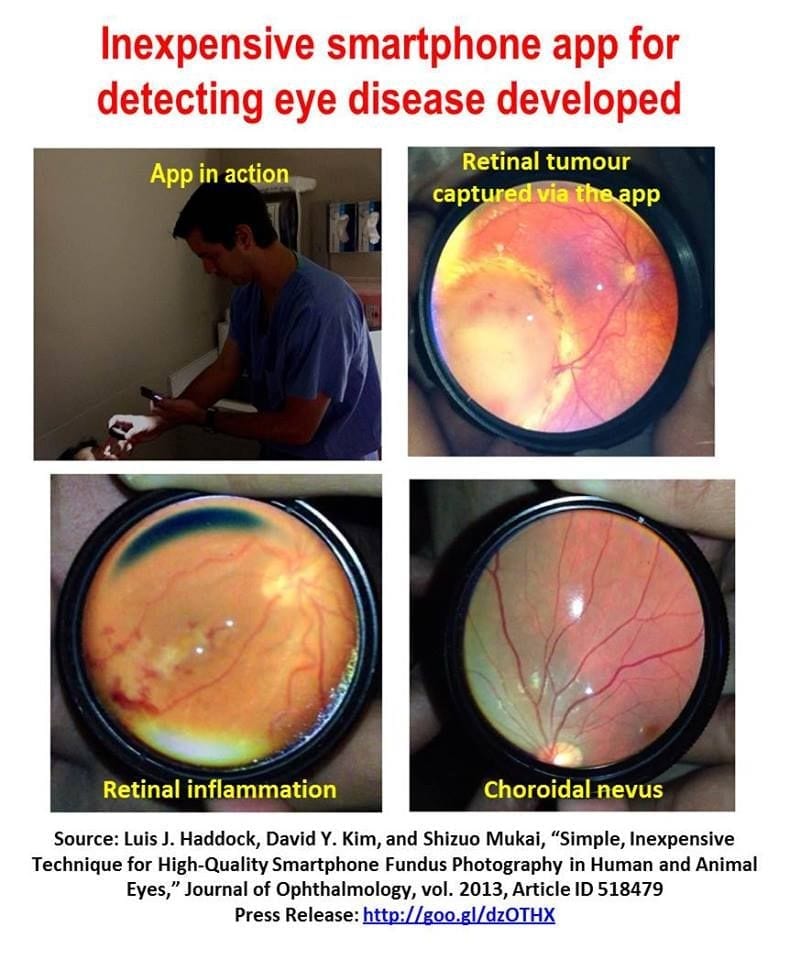
Technology could spawn new generations of smaller, less expensive devices for science, medicine
In an advance that could dramatically shrink particle accelerators for science and medicine, researchers used a laser to accelerate electrons at a rate 10 times higher than conventional technology in a nanostructured glass chip smaller than a grain of rice.
The achievement was reported today in Nature by a team including scientists from the U.S. Department of Energy’s (DOE) SLAC National Accelerator Laboratory and Stanford University.
“We still have a number of challenges before this technology becomes practical for real-world use, but eventually it would substantially reduce the size and cost of future high-energy particle colliders for exploring the world of fundamental particles and forces,” said Joel England, the SLAC physicist who led the experiments. “It could also help enable compact accelerators and X-ray devices for security scanning, medical therapy and imaging, and research in biology and materials science.”
Because it employs commercial lasers and low-cost, mass-production techniques, the researchers believe it will set the stage for new generations of “tabletop” accelerators.
At its full potential, the new “accelerator on a chip” could match the accelerating power of SLAC’s 2-mile-long linear accelerator in just 100 feet, and deliver a million more electron pulses per second.
This initial demonstration achieved an acceleration gradient, or amount of energy gained per length, of 300 million electronvolts per meter. That’s roughly 10 times the acceleration provided by the current SLAC linear accelerator.
“Our ultimate goal for this structure is 1 billion electronvolts per meter, and we’re already one-third of the way in our first experiment,” said Stanford Professor Robert Byer, the principal investigator for this research.
How It Works
Today’s accelerators use microwaves to boost the energy of electrons. Researchers have been looking for more economical alternatives, and this new technique, which uses ultrafast lasers to drive the accelerator, is a leading candidate.
Particles are generally accelerated in two stages. First they are boosted to nearly the speed of light. Then any additional acceleration increases their energy, but not their speed; this is the challenging part.
In the accelerator-on-a-chip experiments, electrons are first accelerated to near light-speed in a conventional accelerator. Then they are focused into a tiny, half-micron-high channel within a fused silica glass chip just half a millimeter long. The channel had been patterned with precisely spaced nanoscale ridges. Infrared laser light shining on the pattern generates electrical fields that interact with the electrons in the channel to boost their energy. (See the accompanying animation for more detail.)
Turning the accelerator on a chip into a full-fledged tabletop accelerator will require a more compact way to get the electrons up to speed before they enter the device.
The Latest Bing News on:
Accelerator on a Chip
- SEMIFIVE Collaborates with MetisX in Developing CXL-based Memory Accelerator Chipon April 24, 2024 at 2:59 pm
SEMIFIVE, a leading design solution provider and pioneer of platform-based custom silicon solutions, has announced a collaboration with MetisX to develop a Compute Express Link (CXL)-based memory ...
- This tiny chip can safeguard user data while enabling efficient computing on a smartphoneon April 23, 2024 at 3:56 pm
A new chip can efficiently accelerate machine-learning workloads on edge devices like smartphones while protecting sensitive user data from two common types of attacks -- side-channel attacks and ...
- MIT’s new powerful phone chip thwarts millions of data theft attacks in testson April 23, 2024 at 11:17 am
A team of researchers from MIT and the MIT-IBM Watson AI Lab has developed a new chip to make health-monitoring apps more secure. These new machine-learning accelerator chips aim to enhance data ...
- RISC-V chip designer Rivos raises 235 million euros for AI acceleratoron April 17, 2024 at 6:05 am
Rivos, a startup that designs RISC-V-based processors, recently raised over 235 million euros ($250 million) to develop its own AI accelerator. This AI ...
- What's Going On With AMD Stock Tuesday?on April 16, 2024 at 11:22 am
AMD announced new Ryzen PRO 8040 Series for business laptops and mobile workstations and Ryzen PRO 8000 Series AI-enabled desktop processor. AI PC shipments expected to account for 22% by 2024.
- Intel Unveiled Its New Artificial Intelligence Chip -- Can It Compete With Nvidia?on April 13, 2024 at 8:30 am
Up until now, Nvidia (NASDAQ: NVDA) has dominated the market for AI chips with an estimated 98% share of the data center GPU market. However, Intel (NASDAQ: INTC) is now throwing its hat into the ring ...
- Intel unveils new AI accelerator chip in bid to gain on Nvidiaon April 12, 2024 at 11:00 am
Intel Corp is rolling out a new version of its artificial intelligence chip, aiming to challenge Nvidia Corp in one of the fastest-growing parts of the semiconductor industry.
- Inside Intel’s Gaudi 3 Chip for AI Training and Inferenceon April 11, 2024 at 11:47 am
The company’s next-gen AI silicon adds more accelerator cores, faster networking, and extra high-bandwidth memory.
- Meta details five-nanometer MTIA chip for accelerating AI inference workloadson April 11, 2024 at 7:06 am
Meta originally made the PEs using Taiwan Semiconductor Manufacturing Co. Ltd.’s seven-nanometer process. With the second-generation MTIA, the company has switched to a newer five-nanometer node. It ...
- Meta unveils second-gen AI training and inference chipon April 11, 2024 at 3:02 am
The second version of Meta's custom silicon is more than three times as fast as its predecessor, thanks to a much larger part and an expansion of the memory capacity on the chip.
The Latest Google Headlines on:
Accelerator on a Chip
[google_news title=”” keyword=”Accelerator on a Chip” num_posts=”10″ blurb_length=”0″ show_thumb=”left”]
The Latest Bing News on:
Contract for the Web
- Sunday digest: Your weekly roundup of the newson April 28, 2024 at 7:23 am
Two local bookstores got caught up in the excitement of Independent Bookstore Day and offered special events, sales and other perks to shoppers all day Saturday. Bookends & Beginnings and Booked ...
- 'Will they be able to take our home?': This Houston couple got tricked into a contract — to pay up to $67K — for 'free' solar panels. Here are 3 legit ways to get cash back ...on April 28, 2024 at 3:43 am
Bernard and Tasa Mosley, a retired couple from Houston, Texas, learned that lesson the hard way when they fell for a scam offering free solar panels. The budget-conscious pair told KPRC 2 ...
- Teamsters Local 952 keeps membership in the dark as Southern California bus drivers contract expires April 30on April 26, 2024 at 8:30 pm
Teamsters Local 952 members are set to vote on a contract that they have no details on. Teamsters will inform membership of the details and rush a vote after.
- Contract Award: Dataminr Inc. (New York, New York) – $59,354,911on April 25, 2024 at 5:00 pm
Dataminr Inc., New York, New York, has been awarded a $59,354,911 modification (P00009) to previously awarded FA7014-21-C-0024 to exercise Option Year Three for web-based, mobile, e-mail, and ...
- AI Safety for Smart Contracts Is AI Safety for the Worldon April 23, 2024 at 10:04 am
Web3 and blockchain technology go far beyond Bitcoin and NFTs. As businesses become more aware of Web3’s possibilities, one feature will play an important role: smart contracts. Smart contracts ...
- Digital Ally wins new contract to provide 120 body cameras for Arrowhead Stadium's security staffon April 23, 2024 at 4:58 am
The team's director of safety and event security said the Chiefs see the "value of deploying ... body cameras as part of our commitment to creating a safe and positive experience for our fans at GEHA ...
- WEB Aruba Signs Water-as-a-Service® BOOT Agreement With Seven Seas Water Groupon April 19, 2024 at 11:54 pm
VBA will construct a new seawater reverse osmosis plant, contributing a total of a minimum of 16,500 cubic meters of daily drinking water per day.
- Google worker fired for pro-Palestinian protest: “Workers are the ones that have the power to stop the genocide”on April 19, 2024 at 6:50 pm
The WSWS spoke Friday with Zelda, a 23-year-old software engineer, who was arrested and fired by Google for participating in a sit-in to protest the company's complicity in the Gaza genocide.
- The AI-Based Smart Contract Audit Firm ‘Bunzz Audit’ Has Officially Launchedon April 9, 2024 at 11:26 am
Comprehensive security checks are now possible at only 10% of the traditional cost. The price and report creation is 10 times faster and cheaper than traditional firms.
- Dad sought hitman on dark web to kill the parents of 5 children he adopted, feds sayon April 8, 2024 at 3:39 pm
After adopting five children, a man wanted their biological parents dead and arranged for their killings on the dark web, according to federal court documents. In visiting a website “dedicated to ...
The Latest Google Headlines on:
Contract for the Web
[google_news title=”” keyword=”Contract for the Web” num_posts=”10″ blurb_length=”0″ show_thumb=”left”]










